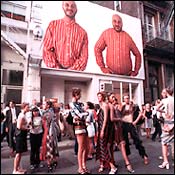REAL ESTATE 1978

I remember the old Soho like it was last Tuesday. I was a happy resident there in the seventies, when it still resembled what a 1962 report by the City Club of New York called “The Wastelands of New York City.” It was an industrial area—by day the turf of truckers and warehousemen, by night the domain of the artists, musicians, and other assorted bohemians who had migrated there in search of wide-open spaces at affordable rates.
I had friends who rented 5,000 square feet for a few hundred dollars a month, often with leases of ten or twenty years. My own space was a mere 1,200 square feet, but it had high ceilings, large windows, and a skylight.
Loft living back then meant a raw space made habitable by any means necessary. The downsides included living with your own plumbing, iffy heat, funky freight elevators or heroic climbs, industrial neighbors and industrial-strength rodents, and spooky streets late at night. The upside: Lofts were big enough to produce museum-size paintings in natural light and to accommodate artists’ penchant for wild dance parties and Ping-Pong.
Artists had been moving to the neighborhood since the fifties, but the modern history of Soho could be said to have begun when Paula Cooper opened her gallery in 1968. Soon afterward, Leo Castelli bought 420 West Broadway, and a true art district was born—a genuine cultural neighborhood.
And as the art world grew and prospered, so did Soho. Many lofts that started out grungy became, over the years, quite habitable, even luxurious. Collectors came to see the work and wound up wanting to buy the studio.
I remember lots of good times—fantastic drunken conversations, great art leaned up against the walls. I remember eating a hearty $1 breakfast in a diner on West Broadway and Prince with a couple of artists and a lot of truckers. I remember civilized dinners at Food, Gordon Matta-Clark’s restaurant. I remember sitting on my fire escape watching the blackout. And I remember the precise moment when Soho became too hot for me.
It was a Sunday in the spring of 1978. According to the prevailing system of reckoning time, EDT, Eastern Disco Time, it was very early morning—before noon. Suddenly, I was awakened by a horrible noise, throbbing and wailing and caterwauling. After I had shaken off the notion that it was a particularly vivid nightmare, my ears began to sort out the true nature of this onslaught: live acoustic folk music.
Outside my window, five floors below, was a quartet of loud, hairy buskers with banjo, guitar, washboard, and jug. My neighborhood had turned into Bleecker Street.
This transformation seemed to have occurred literally overnight. At first, it came in the form of the alfresco exhibitors of paintings who thought they would peddle their oils, aimed at tourists, a little closer to the real art world.
The takeover of the storefronts was more insidious. The galleries brought the rich, and the rich brought the stores, from agnès b. to J.Crew. Soon this neighborhood would be too expensive even for the galleries.
Probably the biggest lesson of Soho was learned early by real-estate speculators, that artists are the ideal shock troops of real estate. Find a spacious hellhole, and give them a few years. When you return, they will have transformed a crumbling warehouse into a showplace that reeks of glamour. Then you will be able to evict the artists and sell the lofts to cosmetic dentists.
But artists are a hardy lot. Since Soho, they have transformed the East Village into safe housing for Wall Streeters, Williamsburg from a slum to a tourist destination, Dumbo into a place where Williams-Sonoma plans to open a store, and, perhaps most notably, Chelsea into Soho. Apparently, creativity knows no bounds, or at least no zoning.
Related Stories
• Wished You Lived Here!: How relentless real-estate hype remade the city, hot nabe by hot nabe.
• Mass Exit to Brooklyn: The F-train became a caravan of dreams for those seeking cheap rents but finding much more. (35th anniversary issue of New York Magazine)